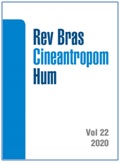Metabolic syndrome components and face shape variation in elderly
DOI:
https://doi.org/10.1590/1980-0037.2020v22e74390Abstract
The aim of this study was to identify the metabolic syndrome (MS) components mostly influencing face shape in elderly individuals. This is a cross-sectional epidemiological study carried out with elderly individuals living in Aiquara County, Bahia State. Facial images at frontal view and MS were classified according to the National Cholesterol Education Program's Adult Treatment Panel III (revised version). Discriminant function, cross validation and distance Mahalanobis D2 were used to extract face shape variations due to MS. Principal Component Analysis (PCA) was used to evaluate MS components’ influence on face shape. The total of 193 elderly individuals were selected; there were significant differences in face shape due to MS (p <0.01) in both sexes. PCA 1 showed HDL-C in men, which accounted for 37% of the total variation. HDL-C in biplot is associated with individuals who do not have MS and with elderly individuals with MS - there was correlation between waist circumference and triglycerides. PCA 1 represented 33.2% of the total variation in women; this outcome is explained by triglycerides. There was association between blood glucose and waist circumference in biplot. HDL-C is related to women who do not have MS. Facial variations affected by MS did not derive from the action of any of the MS components, but from the association between them. Thus, geometric morphometrics emerges as a promising method that makes it possible identifying heart disease and metabolic risk factors according to face shape features.
References
Patil RR. Urbanization as a Determinant of Health: A Socioepidemiological Perspective. Soc Work Public Health 2014; 29 (4): 335–341.
World Health Organization. World Health Statistics 2017: Monitoring Health for the SDGs Sustainable Development Goals. Geneva: World Health Organization. 2017; Disponível em: https://www.who.int/gho/publications/world_health_statistics/2017/en/ [2017 ago 02].
Rochlani Y, Pothineni NV, Kovelamudi S, Mehta JL. Metabolic syndrome: pathophysiology, management, and modulation by natural compounds. Ther Adv Cardiovasc Dis 2017; 11 (8): 215–225.
Expert Panel on Detection, Evaluation, and Treatment of High Blood Cholesterol in Adults. Executive summary of the third report of the National Cholesterol Education Program (NCEP) expert panel on Detection, Evaluation, and Treatment of high blood cholesterol in adults (Adult Treatment Panel III). JAMA 2001; 285 (19): 2486-2497.
O’neill S, O’driscoll L. Metabolic syndrome: a closer look at the growing epidemic and its associated pathologies. Obes Rev 2015; 16 (1): 1–12.
Fingeret M, Marques-Vidal P, Vollenweider P. Incidence of type 2 diabetes, hypertension, and dyslipidemia in metabolically healthy obese and non-obese. Nutr Metab Cardiovasc Dis 2018; 28 (10): 1036-1044.
Oliveira CC, Costa ED, Roriz AKC, Ramos LB, Gomes Neto M. Preditores de Síndrome Metabólica em Idosos: Uma Revisão. Int J Cardiovasc Sci 2017; 30 (4): 343-53.
Lee BJ, Kim JY. Predicting visceral obesity based on facial characteristics. BMC Complement Altern Med 2014; 14: 248.
Mayer C, Windhager S, Schaefer K, Mitteroecker P. BMI and WHR Are Reflected in Female Facial Shape and Texture: A Geometric Morphometric Image Analysis. PLoS One 2017; 12 (1): e0169336.
Nunes LA, Jesus AS, Casotti CA, Araújo ED. Geometric morphometrics and face shape characteristics associated with chronic disease in the elderly. Biosci J 2018; 34 (2): 1035-1046.



